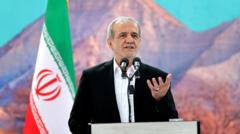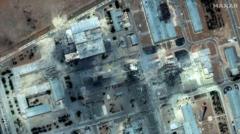As President Trump considers military strikes, the strategic ramifications of targeting Iran's nuclear sites remain a critical point of debate.
U.S. Weighs Risky Strike Options Against Iran's Nuclear Facilities

U.S. Weighs Risky Strike Options Against Iran's Nuclear Facilities
Experts warn that military intervention could lead to severe unintended consequences, recalling past conflicts.
The American B-2 stealth bomber stands as the U.S. military's only aircraft capable of deploying the enormous munitions required to penetrate Iran’s most fortified nuclear installations. However, the potential decision to proceed with such strikes carries significant risk, according to defense analysts.
Imagery of precision airstrikes paints a stark picture—B-2 bombers taking off from bases like Whiteman in Missouri or Diego Garcia in the Indian Ocean, fueled and primed for a dangerous mission. Their target? A mountainous region in north-central Iran harboring the underground Fordo nuclear facility, long identified by U.S. intelligence as a critical threshold in Iran's nuclear ambitions. This facility gained notoriety when its existence was disclosed in 2009, prompting claims of deception from Iranian leadership.
Despite extensive deliberation and preparation, the mission is fraught with uncertainties. Experts point out that the risk of unintended consequences looms larger than in previous military campaigns, such as Iraq and Afghanistan. Donald Rumsfeld's famous proclamation about “known unknowns” and “unknown unknowns” aptly encapsulates the extent of these unpredictable dangers.
As President Trump mulls over military options, he shifted tone from aggressive rhetoric to caution, stating, “I may do it… I mean, nobody knows what I’m going to do.” The future of U.S.-Iran relations, along with broader implications for Middle Eastern stability, hangs in a delicate balance as decisions become increasingly pressing.
Imagery of precision airstrikes paints a stark picture—B-2 bombers taking off from bases like Whiteman in Missouri or Diego Garcia in the Indian Ocean, fueled and primed for a dangerous mission. Their target? A mountainous region in north-central Iran harboring the underground Fordo nuclear facility, long identified by U.S. intelligence as a critical threshold in Iran's nuclear ambitions. This facility gained notoriety when its existence was disclosed in 2009, prompting claims of deception from Iranian leadership.
Despite extensive deliberation and preparation, the mission is fraught with uncertainties. Experts point out that the risk of unintended consequences looms larger than in previous military campaigns, such as Iraq and Afghanistan. Donald Rumsfeld's famous proclamation about “known unknowns” and “unknown unknowns” aptly encapsulates the extent of these unpredictable dangers.
As President Trump mulls over military options, he shifted tone from aggressive rhetoric to caution, stating, “I may do it… I mean, nobody knows what I’m going to do.” The future of U.S.-Iran relations, along with broader implications for Middle Eastern stability, hangs in a delicate balance as decisions become increasingly pressing.






















